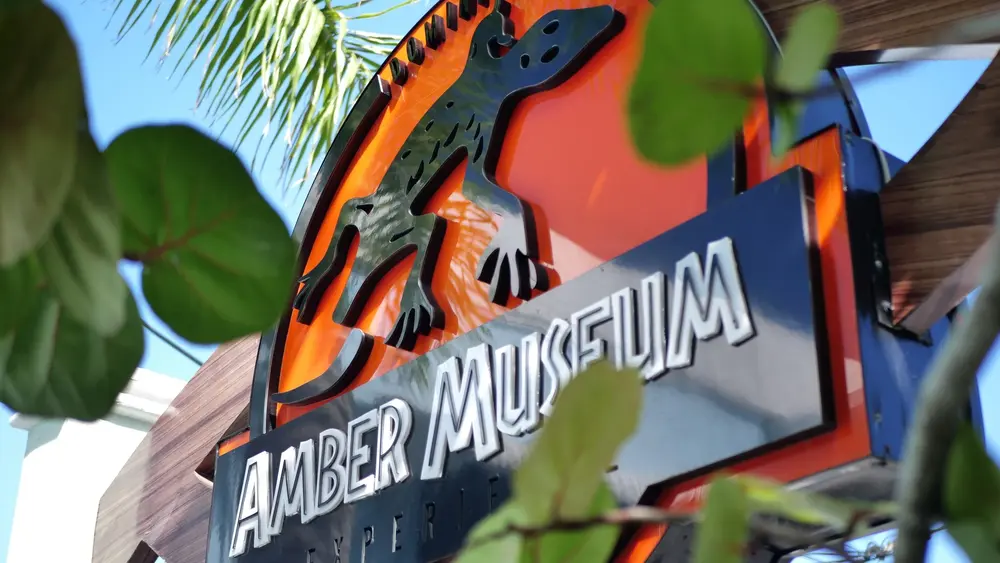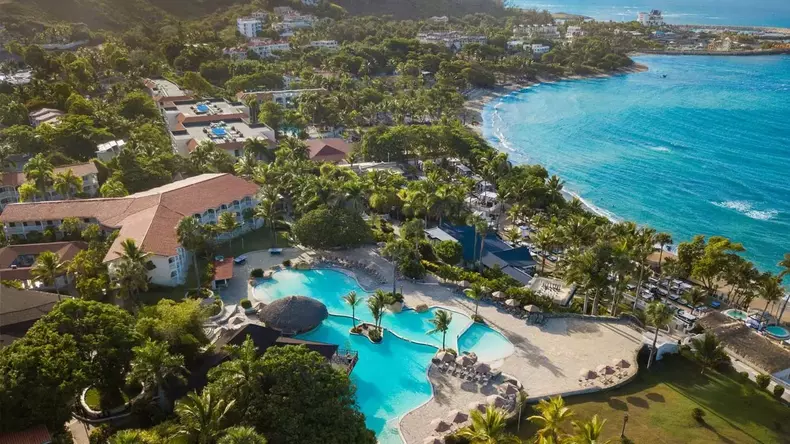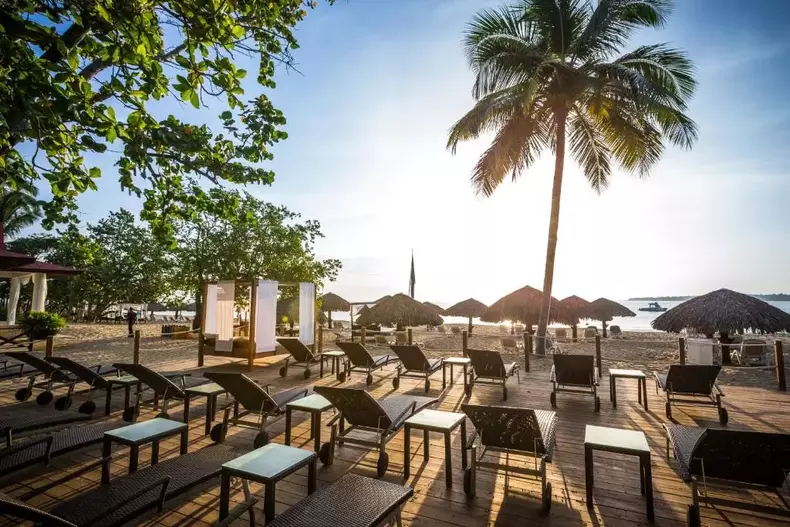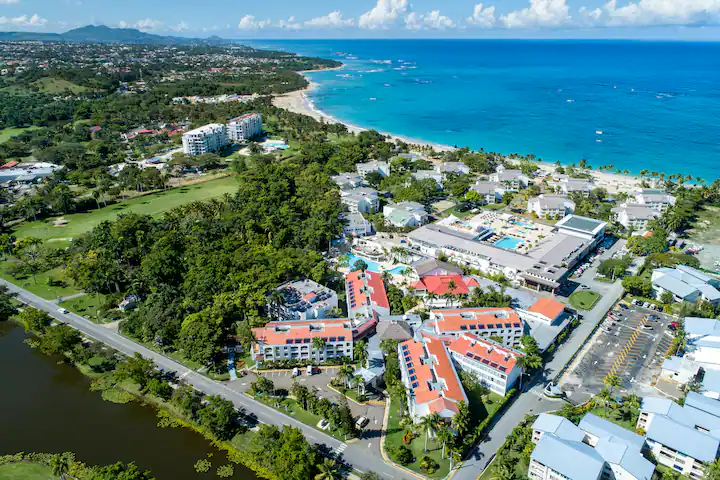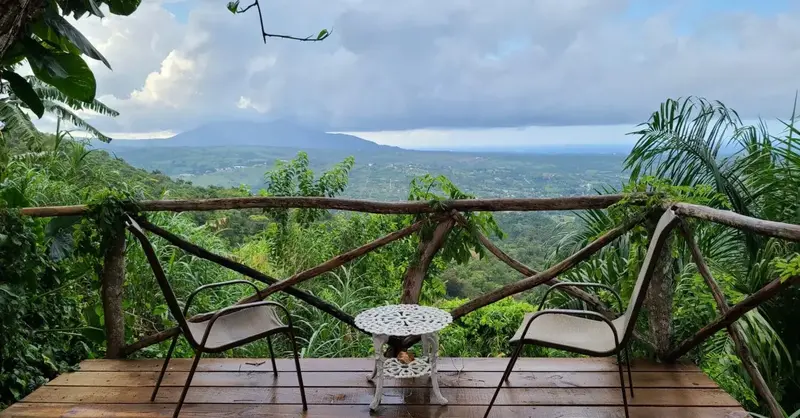Amber Museum,Puerto Plata
The Amber Museum of Puerto Plata can be considered a time capsule, a window to our prehistoric past, for the past 40 million years.
Dominican Amber is considered among the most valuable in the world. This semi-precious gem formed during the Tertiary and Mesozoic periods, 25-40 millions of years ago. Ancient Conifer trees produced a sap that oozed out of its branches, in many cases trapping leaves, birds, insects and small animals like geckos.
Once fossilized, it became a time capsule, preserving the trapped species for millions of years. This sticky resin hardened into a warm golden gem later to be known as amber. It has been appreciated for its color and natural beauty since the Neolithic times. There are five classes of amber, and when it contains animal or plants inside, its called inclusions.
The Amber museum has several display rooms, with an impressive collection of pieces of many sizes, containing plants, insects and other fossilized small animals ( a highlight is a 20 million year old gecko, completely preserved ).
The tour guide explains the history of amber in about 4 minutes and guides visitors through the museum exhibits, in various languages ( we witnessed him speak French, English, German and Spanish ).
The first floor of the building has a store with gift shop where amber jewelry is on display for sale, and other Dominican handcrafts. The vendors are not pushy, always smiling and used to people visiting to admire the building and the museum exhibits.
The word amber has its roots in the Arabic, Anbar. It has been discussed as early as the 4th Century BC. For amber to become fossilized, the initial resin must be resistant to decay; amber that was quickly covered with mud and vegetation was protected from the sun and elements including fungi and bacteria. Some believe the Dominican Republic amber came from the Hymenaea Protera, a prehistoric tree from the Leguminoseae family.
- Jurassic Park: Dominican amber became world famous in the mainstream when the film Jurassic Park (1993) opened in theaters, with an initial scene of amber mining in the Dominican Republic; they found a mosquito from which a dna sample was taken, and a dinosaur sequenced back to life on a lab. The Amber Museum in Puerto Plata has a display wall with newspaper and magazine clips, also a replica of the walking cane Dr. Richard Attenborough used in the movie, which has a fossilized rock with a trapped mosquito in it.
- FROZEN IN TIME: a prehistoric window to our past, from around the world.
The formation of amber results from a molecular polymerization, which results from high temperatures and pressures by overlying sediment, that turns the resin into the initial stage known as Copal ( 1 million years old ). Further pressure and heat results in amber.
- Paleontological Significance: amber is a unique time machine, that preserves unfossilizable parts of species and helps reconstruct ecosystems and organisms going back millions of years. Cretaceous amber has yielded the most fossilized species, and the oldest amber is from the Triassic period, some 230 million years ago.
- Mining: Amber is globally distributed, mainly in rocks from the Cretaceous age or younger. Baltic amber is famous, and the leading source (90%) is the Kaliningrad Oblast from Russia. It is mined in open works and underground galleries. In the Dominican Republic it is mined through bell pitting, which poses greater risks due to collapse.
- Blue Amber: This amber exhibits a rare blue coloration. It is found in the mines along mountain ranges of Santiago, Dominican Republic. A research by Vittorio Bellani and Enrico Giulotto from the University of Pavia in Italy found out that the blueness is likely produced by Perylene. Blue amber is more valuable than the standard golden one, due to its rareness.
- Villa Bentz: One interesting aspect of the museum is the Victorian architecture and history of the mansion that houses it, originally built during the economic boom of Puerto Plata during the early 18th Century by Emil Bentz, an European immigrant from Germany who met Maria Hatchmann in Puerto Plata, fell in love and married her in 1865. They became successful merchants, had a big family with 7 children and decided to build the villa, completed in 1919 by Spanish architect Martin Gallart.
Information Of Amber Museum
- A walk through the center of town (Parque Central) will take you to the resplendent white towers of the Church of San Felipe.
- At about 100 meters on Duarte street you’ll find The Amber Museum.
An outstanding example of Victorian architecture, the museum houses a unique collection of valuable Dominican amber. - Experts say this amber is known to be the most transparent in the world. Amber is classified as semiprecious and is actually tree sap that has hardened for millions of years, capturing many fossils of plant and insect life.
- Phone Number: (809) 734-2599
Guided tours in several languages are given Monday through Saturday from 9am to 6pm.
The Amber Museum shops offer a full selection of Dominican amber jewelry, both in Puerto Plata and in Playa Dorada Plaza.
History Of Amber Museum
In 1980, after the restoration of Villa Bentz, it was decided to expose the fossil collection, which was too important to have hidden it in a safe. At the same time, Brandt Ghepart appeared, American paleontólogist, museólogist, that had worked for fifteen years in the museum of natural history of Cleveland, USA, man of much sensitivity, artist with multiple capacities, as well in the fields of the painting and music: he plays the flute, violin, arp and drums. Brandt arrived in Puerto Plata like solitary navigator with his small yacht. She was born immediately affection and mutual understanding between Brandt and the family Coast and given the importance of the collection shared the idea to make a suitable work.
Brandt, conquered by the variety of amber with his insects, leaves, flowers, conserved perfectly in the prehistoric resin, as if outside a magical box, sold his boat and Silver settled down in Port, and took the decision to form the museum dreamed by several years by Doña Didi.
The meticulous work of preparation, cataloguing, study of the ground and subsoil, selection of stones with its photographies or drawings done with the aid of the microscope lasted two years. The way was studied to link stones with metal thread in gold bath, work handmade for greater resistance and lights were used you cold not to damage stones, and were made macro-photos with aid of a put camera upon the microscope.
The museum, dream of many years with a sense of exectancy, was opened in March of 1982. The collection was composed of thousands of pieces, allyhough all is not exhibited. Some are very beautiful and very rare.
Of the exhibited ones, the most studied and appreciated is a lizard of 40 centimeters in a state of perfect conservation that dates from about 30 to 40 million years ago. The lizard is included in an amber piece with a length of 42,5
centimeters.
One extraordinary piece is formed with the drops of a resin falling after the other, forming little tubes that seem like needles of coniferous.
The fame of the Museum of Dominican Amber spread outside The Dominican Republic. The international tourguides mentioned it as a place of cultural interest, and the museum grew by visitors very fast. Today a visit at the museum is as natural as the beach for the visitor.
Villa Bentz
The story of this building begins more than one hundred years ago, like a fairy tale or the sweet dreams of a romance lost as time goes by.
Around the middle of the past century, a schooner leaves the Bremen harbour in Germany and sails the stormy water of the Atlantic Ocean bound to the city of Puerto Plata, in the Dominican Republic.
Aboard the schooner, together with many other emigrants from all Europe seeking their fortune in far countries, is Emil Bentz a young German, who is taking with him all his hopes and wishes indispensable to meet the journey to his future.
In the course of the long days of sailing, Emil meets little all the passengers: businessmen, adventurers, families going to meet with their relatives or simply emigrants like him, wishful to engage in a new life or to look for new opportunities on the other side of the Ocean.
Day by day, Emil realizes to have strong feelings for Maria Hatchmann, the shooner captain’s young and lean daughter: her tenderness, kindness and large blue eyes make him fall deeply in love.
The days follow the nights and the nights follow the days: the mutual liking turns into a deep feeling.
A shining sun, the gentle breeze of the Caribbean and a lot of people are waiting in Puerto Plata harbour for the arrival of the German schooner, loaded with many expectations and humanity.
Emil and Maria fulfill their dreams for love and marry a few month later, around 1865. In the following years they open, near the harbour area, the most elegant hotel in Puerto Plata, were most of the foreign travelers go to.
In 1870 Arturo, their first son, is born followed by three more sons and one daughter.
In the last years of the past century, Augusto Bentz and his brother Rodolfo open a pulpier(grocery store) near the “Guinea” bridge and their business are increasing: at the beginning of this century, together with two associates, Mr. Folch, they buy the ingenio Amistad ( Amistad Sugar Mill), named to honor the brotherly union, near the town of Imbert, and shortly after they adquire the Ingenio Montellano.
The Bentz family is now being part of merchant bourgeoisie of Puerto Plata; things are going very well and the symbols of opulence are evident: Augusto and Rodolfo are the first car owners in Puerto Plata.
Augusto marries in the first year of this century with Carolina Castán, the daughter of a Spanish immigrant. They have 7 children: their family is now very large and Augusto Bentz charges in 1918 the famous Spanish architect Martín Gallart y Canti to build a big residence, the Villa Bentz, presently place of this Amber Museum.
In December of 1919, once the construction finished, the Bentz family takes possession of the new house, a dream great like a white castle.
Augusto Bentz, the head of the family, a short and lean man, with a stern glance but with warm heart, is an exemplary father for his children; Carolina, his wife, short dark-haired and always elegant in her dresses, is so sweet and infinitely forbearing with her creatures.
On January 11th, 1920, the wedding of Luisa, their eldest daughter, with Agustín Puig, is the opportunity for a big party at the villa: the bride, gorgeous in her white-dress,the elegant guests, the children who fill with their laughs and screams the air of joy,the tables covered by Flanders laces, the beautiful plates with silvers covers, all kinds of food, together with Veuve Cliquot champagne and the best brands of rum, whisky and beer…
The elegant building, called at that time La Casa Blanca ( The White House), Neoclassic in style, stands on the West corner of the crossing of Duarte and Emilio Proud’homme streets; it has a wide gallery on three sides with classical columns and its blueprint is in the Puerto Plata style with Spanish tradition: a main building and a wing with bedrooms and utilities on the backside, adjacent to the court.
Classical motifs repeat the ornamental details of iron and wood in friezes, cornices, balconies, ventilators and door-jambs, with some original interpretations in the elements and the decoration of the classical architectural repertoire.
During several years, on every weekend, the Villa becomes lively when all the Puerto Plata “nice people” attend the receptions and the parties given by the Bentz:tastefully dinners on the roof, with a great profusion of the most excellent and delicious pastries and liquors, interlaced flowers, sumptuous and giddy dances in the ballroom: the orchestra is very clever to diffuse harmonious melodies that inebriate everybody’s souls with turning waltzes and mazurkas and that give brilliance to the beauty and the dresses of all the ladies, charming in the air of magic that fell the ambience.
Time seems to forget the daily problems and the Bentz family sails the high waves of opulence.
The first warning of danger appear and make real with the great economic depression in 1929,that force Augusto and Rodolfo to sell their Sugar Mills, due the great world crisis: the sugar price falls from 25 pesos to 1 peso per quintal (100 kg).
Following Augusto’s death in 1933, the Bentz family is forced to lower its level of living and gives for rent the Villa, which will be for several years a Secondary School, attended by all the Puerto Plata bourgeoisie’s children.
Around the middle of the ‘50s is established in the building a school of housewifery, that gives free of charge a succession of very interesting courses, and in 1957 opens its doors a school of painting, that graduates many today well-known artists.
The years after 1961 are for the building a long period ofneglect, abandon and deterioration until 1973, when the Hotel Colonial starts its activity, with the main presence of the many businessmen visiting Puerto Plata.
In 1977 Mr. Aldo Costa and his wife Didi, an Italian couple established in Puerto Plata from a longtime, buy the property and opens the tourist bazaar boutique.
60 years have passed since the building of the large white Villa and and the entire structure urgently needs a lot of works for its restoration: the Costa family, with its natural Italian artistic mind, realizes to own a great artistic treasure, a unique in the architectural panorama of Puerto Plata, and decides to exhaust its efforts anda lot of money to give again the original look the building.
In 1980 important works are started and, almost 2 years later, Puerto Plata meets again the jewel born in 1919.
On March 30th, 1982, is opened the Amber Museum, the first in the Dominican Republic, that draws not only a lot of tourists but offers itself, in the same time, like a focus for international researches.
During the first months of 1997 almost 80 years after its building, the Villa Bentz is in great array with a second course of works to open the museum’s new department: the elegant Neoclassic structure is now beautiful for the passers-by and the visitors, the inner halls evoke the memory of the ancient parties, many pieces of art and wonderful details adorn every corner of the building, the splendid scientific collections of amber are on display in a very original way.
By night, under the moonlight and gentle Caribbean breeze, in the deep silence of the asleep city, could hear, around the large halls of the Villa, light melodies of waltz and the gentle clinking of two glasses with champagne, to celebrate and welcome the memory for the new century.
Meaning
What is amber?
- A semi-precious gem formed out of the fossilized resin of ancient trees .
- Age varies from 20 Million years up to 245 Million years
Dominican Amber ranges from 25-40 Millions years (Tertiary period) . - Tertiary period is from 1.6M to 66M .
- Mesozoic period is from 66M to 245M.
Ambers origins
- Million years ago large stands of forests in some parts of the world began to seep globs of sticky resin.
- The probable tree for Dominican amber is the Hymenaea protera (family Leguminoseae).
- The tree is now extinct but “Algorrobo” is a probable descendant.
- This aromatic resin went down the sides of trees, as well as filling internal fissures, trapping debris, such as seeds, leaves, feathers and insects.
- As geologic time progressed the forests were buried and the resin hardened into a soft, warm, golden gem,
known as amber.
The formation of amber
- The starting resin must be resisant to decay (both physical = sun ligth, or biological = bacteria & fungi).
- Any type of protection would favor preservation of resin and therefore amber formation (resin rapidily covered by vegetation and soil) .
- The first step of fossilization is polymerization (small molecules = monomers will form large network of molecules = polymers), at this stage the resin is called COPAL. (less than 1M year) .
- After a few millions years copal under the rigth condition of temperature and pressure then becomes AMBER.
Contact
We are always glad for your feedback, and please feel free
to contact us for your reservation or for any questions you might have.
Visiting adress:
Calle Duarte 61, Puerto Plata
Mailing adress:
Amber Museum
Costa Foundation
P.O Box 273
Puerto Plata, Dominican Republic
Telephone:
809-586-2848 (Information)
809-320-2215 (Giftshop)
809-586-8518 (Fax )
Price
• RD$200.00 / Ticket
Faq's
¿What is the price of Amber Museum, Puerto Plata?
• RD$200.00 / Ticket
¿Where is it located Amber Museum, Puerto Plata?
The Amber Museum is located in the center of the beautiful city of Puerto Plata, Dominican Republic, a few meters from Independencia Park.
¿How can I get to Amber Museum, Puerto Plata?
It is very easy to get to the place, it all depends on where you are, most routes pass near the City Center, you just have to tell it that you are going to Amber Museum, Please" and after you arrive you are two corners away. destination, you can also download the app Travelerd: Family Travel Guide, travel with your GPS and find the places that are close to you.
¿Which hotels are close to Amber Museum, Puerto Plata?
- BlueBay Villas Doradas
- Emotions By Hodelpa Playa Dorada
- Blue JackTar
- Viva Wyndham V Heavens – All-Inclusive Resort
¿What are the opening hours of to Amber Museum, Puerto Plata?
Hours and calendar of Operation:
- Monday to Saturday: 9:00 to 17:00
Sunday: Close
¿What do I need to know about to Amber Museum, Puerto Plata?
The Amber Museum of Puerto Plata can be considered a time capsule, a window to our prehistoric past, for the past 40 million years.
Jurassic Park: Dominican amber became world famous in the mainstream when the film Jurassic Park (1993) opened in theaters, with an initial scene of amber mining in the Dominican Republic; they found a mosquito from which a dna sample was taken, and a dinosaur sequenced back to life on a lab. The Amber Museum in Puerto Plata has a display wall with newspaper and magazine clips, also a replica of the walking cane Dr. Richard Attenborough used in the movie, which has a fossilized rock with a trapped mosquito in it.
¿ How many visits have Amber Museum, Puerto Plata?
Receives 36,000 tourists arrive each year

